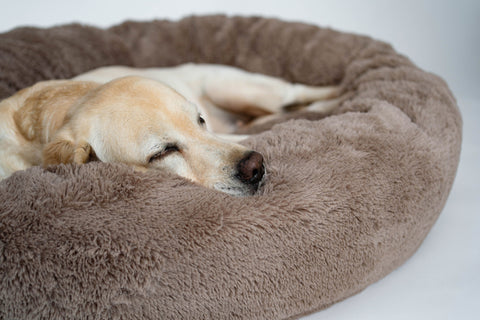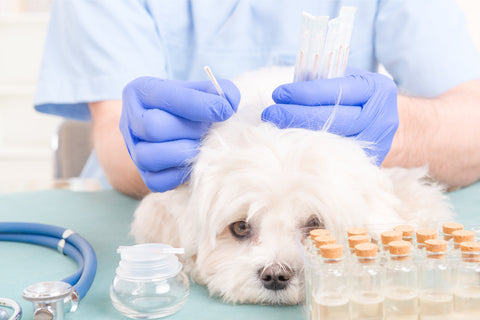

The dangers of autumn for your dog
It’s that time of year again. The nights are growing longer, Strictly’s back on TV, and everything is available in pumpkin spice flavour. But as we settle into autumn’s cosiness with a mug of cocoa, it’s also worth remembering that there are some seasonal dangers to keep in mind when taking your dog out for a bracing walk.
While some of these tips may be common sense, others could prove unexpected, so read on for our top tips on keeping your pup safe and healthy during these autumn months…
Dog walks during dark evenings
If you and your dog tend to venture out into areas that aren’t well-lit – think country lanes and footpaths, for example – walking at the beginning and end of the day can be dangerous. In situations like these, especially, it’s best to keep your dog on a lead as much as possible – bonus points for a reflective lead, harness, or dog coat, which will help you stand out to drivers and other walkers.
Of course, it’s even better if you can stick to familiar routes on large, well-illuminated roads.
Wherever you’re walking, always remember to dress appropriately to ensure visibility, comfort, and warmth. We recommend a thick, waterproof coat, hardy footwear, and a hi-vis vest or head torch.
Wet fallen leaves
One of the best things about autumn is the glorious display of colourful leaves that Mother Nature treats us to. However, once they’ve settled on the ground, they can present a few dangers you need to be aware of.
Firstly, fallen leaves plus rain equals an accident waiting to happen. Both you and your dog could easily lose your footing on those slippery leaves, and that could result in injury. And don’t forget there are often perils lurking beneath the leaves – hidden dog poo or, much more dangerous, broken glass.
If you do find a foreign object in your pooch’s paw, don’t attempt to remove it yourself, as it could cause more damage. Try to keep the area as clean as you can and pay a visit to your vet as soon as you can.
Joint stiffness
We’ve all probably heard that cold can supposedly wreak havoc on our joints, but is there any truth to that?
Well, sort of.
Joint issues tend to be aggravated, not by the cold or damp, but more so by the changes in barometric pressure, plus decreased levels of physical activity and increased nerve sensitivity. So, if your dog isn’t bounding out the door like they normally would when you shout, “Walkies!” and seems slower to get off their bed, it could all be down to joint stiffness.
To help support your dog’s joints during the autumn months – and all year round – we’d suggest giving them browsing our joint supplements for dogs.
Conkers
Although conker tournaments don’t happen as much in school playgrounds anymore, conkers are still a well-known sign that autumn is in full swing. Around September, those shiny mahogany seeds fall from horse chestnut trees, contained in bright green spikey shells. And once they burst open, the contents can be irresistible to kids of all ages. But what about your canine companion?
As a rule, dogs generally aren’t that interested in conkers, thanks to their bitter taste. However, they can be extremely toxic to dogs, so it’s important to stay vigilant for conker-heavy areas when out and about, and to ensure that your pup isn’t trying to eat any.
Keep a particularly watchful eye on puppies who, thanks to their inquisitive natures, are especially tempted by those glossy “toys” they find on the ground. Since conkers can be choking hazards as well as being toxic to dogs, if you think your canine companion has eaten one, you should take them to your vet without delay. To find out more about the dangers of conkers to dogs, check out our blog on the subject.

Wild mushrooms
Come autumn, you’ll see mushrooms popping up all over the place – most commonly in woodland areas, but you may find some in your garden, too.
Unfortunately, a select few wild mushrooms are poisonous to dogs, and your pup can become very ill if they eat them. Teaching your dog to “leave it!” if they spy a mushroom is a great start, but it’s also a good idea to clear any suspect-looking fungi from your lawn as part of your gardening routine.
Even though many mushrooms in the UK are edible and completely harmless, it’s always important to err on the side of safety and make sure your dog steers clear. In fact, we’d even recommend that you avoid feeding your dog safe, cooked mushrooms at home, just in case it could result in them seeking out and sampling mushrooms in the wild.
If you suspect your dog has eaten a wild mushroom, get them straight to your vet – along with a sample of the mushroom, if possible. That way, your vet will know the best course of action to take.
Fallen fruit
The poet Keats may have waxed lyrical about autumn fruits, but those fallen apples are certainly not a dog’s best friend.
Once they’ve fallen from the tree and have been left for a while, fruit starts to go bad and ferment – with rotten fruit containing toxins that can cause muscle tremors and dangerous convulsions in dogs.
What’s more, fermented fruit produces alcohol, which is a definite no-no for your pup. Certain fruits, such as plums, also contain stones that can cause digestive upsets and illness and may also pose a choking hazard. If you do have fruit trees in your garden, always throw away fruit that drops to the ground, and check for windfalls. And be sure to keep your dog away from fallen fruit when you’re out for walkies.
Seasonal canine illness
Seasonal canine illness – or SCI – most commonly affects dogs between August and November, so it’s definitely something to watch out for come autumn.
As it stands, SCI has no known cause, but impacts dogs shortly after walking in woodland. Sadly, SCI can be fatal if it’s not treated early enough.
Symptoms of SCI usually appear 24-72 hours after walking in wooded spots, with the main ones including vomiting, diarrhoea, loss of appetite, abdominal pain and muscle tremors. It’s important to take your dog to your vet as swiftly as possible if you suspect they have SCI. With adequate care from a vet – including fluids and antibiotics – many dogs make a full recovery from this condition.
Regular physical activity is important for dogs all year round, but it’s important to adapt your walks to the demands of the season and to the appropriate level for your pet. You can also give your dog Joint Care for Dogs all year round, to help support their active life, for life.






